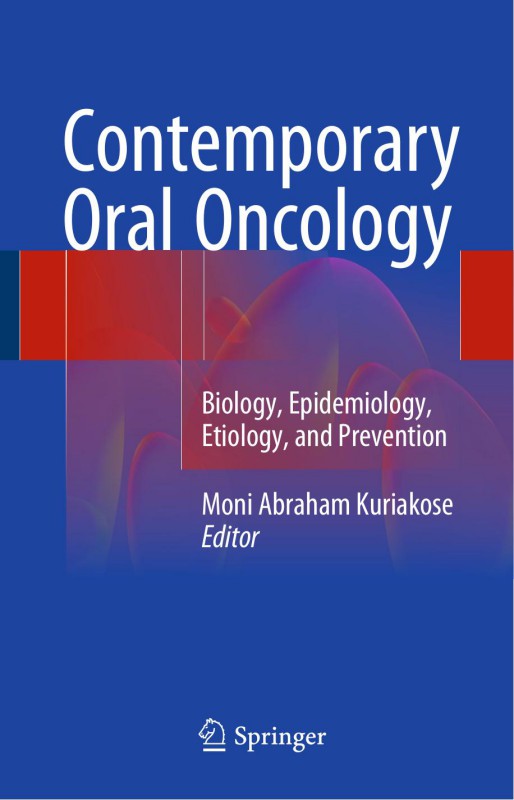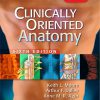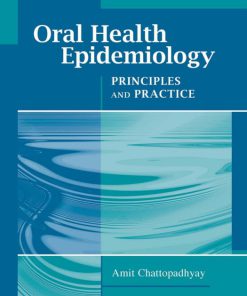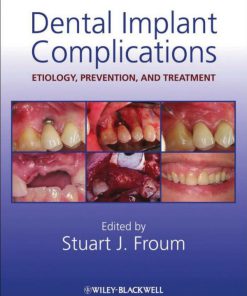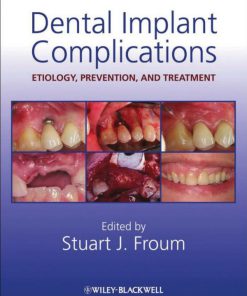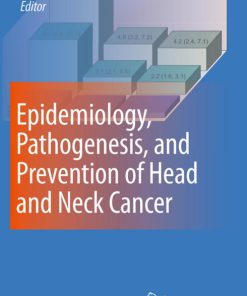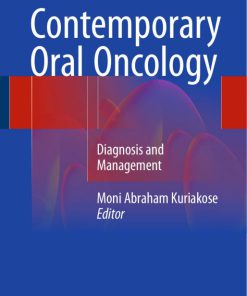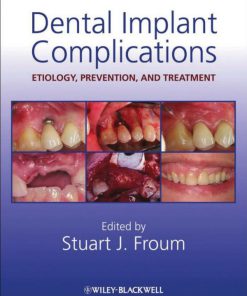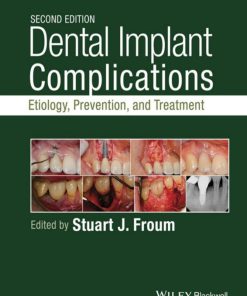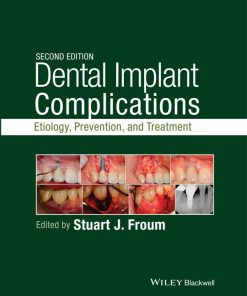Contemporary Oral Oncology Biology Epidemiology Etiology and Prevention 1st edition by Moni Abraham Kuriakose 9783319149110 3319149113
$50.00 Original price was: $50.00.$25.00Current price is: $25.00.
Authors:Moni Abraham Kuriakose , Series:Dentistry [62] , Tags:Medical; Surgery; Oral & Maxillofacial; Dentistry; General; Clinical Medicine , Author sort:Kuriakose, Moni Abraham , Ids:Goodreads; Google; 9783319149103 , Languages:Languages:eng , Published:Published:Dec 2016 , Publisher:Springer , Comments:Comments:This is the first of four volumes that together offer an authoritative, in-depth reference guide covering all aspects of the management of oral cancer from a multidisciplinary perspective and on the basis of a strong scientific foundation. This volume, on tumor biology, epidemiology, etiology, emerging role of cancer stem cells and prevention of oral cancer, opens by discussing oral carcinogenesis in general and the role of particular carcinogens and human papillomavirus. Global epidemiology and changes in disease prevalence are then addressed. Up-to-date information is provided on emerging cancer biomarkers, and the biologic basis of personalized therapy is explained. Histopathological features of malignant and premalignant neoplasms and their relevance to management are described. Further chapters focus on the current status of chemoprevention, the management of oral submucous fibrosis, and the value of various diagnostic adjuncts. The volume concludes by critically evaluating the efficacy of oral screening methods.Volume 1: Biology, Epidemiology, Etiology, and PreventionVolume 2: Diagnosis and ManagementVolume 3: Oral and Maxillofacial Reconstructive SurgeryVolume 4: Rehabilitation and Supportive Care
Contemporary Oral Oncology Biology Epidemiology Etiology and Prevention 1st edition by Moni Abraham Kuriakose – Ebook PDF Instant Download/Delivery.9783319149110,3319149113
Full download Contemporary Oral Oncology Biology Epidemiology Etiology and Prevention 1st edition after payment
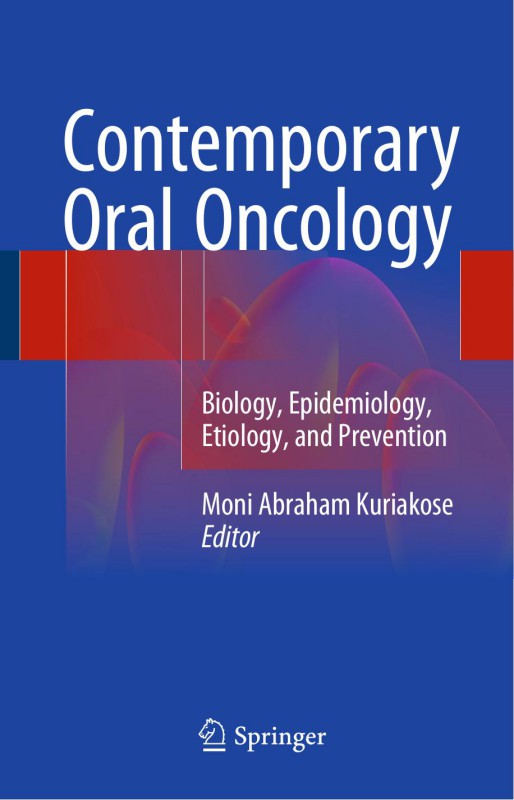
Product details:
ISBN 10:3319149113
ISBN 13:9783319149110
Author:Moni Abraham Kuriakose
This is the first of four volumes that together offer an authoritative, in-depth reference guide covering all aspects of the management of oral cancer from a multidisciplinary perspective and on the basis of a strong scientific foundation. This volume, on tumor biology, epidemiology, etiology, emerging role of cancer stem cells and prevention of oral cancer, opens by discussing oral carcinogenesis in general and the role of particular carcinogens and human papillomavirus. Global epidemiology and changes in disease prevalence are then addressed. Up-to-date information is provided on emerging cancer biomarkers, and the biologic basis of personalized therapy is explained. Histopathological features of malignant and premalignant neoplasms and their relevance to management are described. Further chapters focus on the current status of chemoprevention, the management of oral submucous fibrosis, and the value of various diagnostic adjuncts. The volume concludes by critically evaluating theefficacy of oral screening methods. Volume 1: Biology, Epidemiology, Etiology, and Prevention Volume 2: Diagnosis and Management Volume 3: Oral and Maxillofacial Reconstructive Surgery Volume 4: Rehabilitation and Supportive Care
Contemporary Oral Oncology Biology Epidemiology Etiology and Prevention 1st Table of contents:
1: Carcinogenesis and Field Cancerization in Oral Squamous Cell Carcinoma
1.1 Oral Carcinogenesis
1.1.1 Clinical Progression of Oral Cancer
1.1.1.1 Potentially Malignant Lesions
1.1.2 Histological Progression
1.1.3 Molecular Model of Progression
1.1.4 Biomarkers of Oral Carcinogenesis
1.1.4.1 Tumor Suppressor Genes (TSG)
1.1.4.2 Cell Cycle and Proliferation Markers
1.1.4.3 Angiogenesis and Metastatic Markers
1.1.4.4 Cytokeratins
1.1.4.5 miRNA Markers
1.1.5 Cancer Stem Cells in Oral Carcinogenesis
1.1.6 Markers of Oral Carcinogenesis: Implications in Early Detection and Chemoprevention
1.2 Field Cancerization in Oral Cancer
1.2.1 Cellular Basis of Field Cancerization
1.2.2 Molecular Models of Field Cancerization
1.2.3 Biomarkers of Field Cancerization
1.2.3.1 TP53 Mutations
1.2.3.2 Loss of Heterozygosity
1.2.3.3 Telomerase
1.2.3.4 Ploidy Analysis
1.2.3.5 Angiogenesis Markers
1.2.3.6 Other Markers
1.2.4 Cancer Stem Cells in Field Cancerization
1.2.4.1 Implication of Field Cancerization in Diagnosis and Therapy in Oral Cancer
1.2.4.2 Definition of Terminology
References
2: Aetiology of Oral Cavity Cancer
2.1 Introduction
2.2 The Theory of Carcinogenesis (See Vol. I, Chap. 1 for Details)
2.3 Epidemiology of Oral Cancer (See Vol. I, Chap. 4 for More Details)
2.4 Oral Potentially Malignant Disorders (See Vol. I, Chap. 10 for More Details)
2.5 Clinical Presentation of OSCC and OPML
2.6 Risk Factors for OSCC
2.6.1 Tobacco
2.6.1.1 Cigarette and Cigars
2.6.1.2 Smokeless Tobacco
2.6.1.3 Waterpipe Smoking (aka Hookah, Sheesha, Shisha and Narghile)
2.6.1.4 Areca Nut/Betel Quid
2.6.2 Alcohol
2.6.2.1 Alcohol and Oral Cancer: Epidemiological Evidence
2.6.2.2 Molecular Mechanisms of the Genotoxicity of Alcohol in Relation to Oral Carcinogenesis
2.6.2.3 Acetaldehyde
2.6.2.4 DNA Adducts from Acetaldehyde
2.6.2.5 Chromosomal and DNA Damage by Acetaldehyde
2.6.2.6 Induction of CYP2E1
2.6.2.7 Oxidative Stress
2.6.2.8 Lipid Peroxidation
2.6.2.9 Enhanced Penetration of Carcinogens
2.6.3 Alcohol-Containing Mouthwashes
2.6.3.1 Alcohol-Containing Mouthwashes and Oral Cancer: Epidemiological Evidence
2.6.3.2 Alcohol-Containing Mouthwashes and Oral Cancer: Mechanistic Evidence
2.6.3.3 Unifying Hypothesis
2.6.4 Microorganisms
2.6.4.1 Human Papillomavirus
2.6.4.2 Candida
2.6.5 Diet
2.7 Immune Deficiency and Transplantation
2.8 Genetics, Syndromes and DNA Repair Defects
2.9 UV and Lip Cancer
References
3: Human Papillomaviruses and Squamous Cell Carcinomas of Head and Neck Region
3.1 HPV Genome and Proteome
3.2 Biology of HPV
3.3 Molecular Pathology of HPV Carcinogenesis
3.4 HPV-Associated Oral Diseases: Diverse Manifestations
3.5 Epidemiology of HPV in HNSCC
3.6 HPV-Associated HNC: Clinical Outcome in an Altered Entity
3.7 HPV Detection in Clinical Samples
3.8 HPV Vaccinology
3.9 Therapeutic Vaccines
3.10 Future Perspectives
References
4: Epidemiology and Site-Specific Risk Factors for Oral Cancer
4.1 Introduction and Overview
4.2 Cancer Registries
4.3 Why Collect Detailed Epidemiological Data?
4.3.1 Geographical Epidemiology
4.3.2 Differences by Sex
4.3.3 Differences by Race/Ethnicity
4.4 Age Distributions
4.5 Mortality Rates and Trends over Time
4.6 Mortality Trends by Birth Cohort and Forward Projections
4.7 Global Scenario of Oral Potentially Malignant Disorders (OPMD)
4.7.1 Global Prevalence of OPMD
4.7.2 Age and Gender Distribution of OPMD
4.7.3 Malignant Transformation of OPMD
4.8 Site-Specific Risk Factors for Oral Cancer (ICD 10, C00–C06)
4.8.1 Lip Cancer (ICD 10, C00)
4.8.2 Cancer of the Oral Tongue (C001–C002)
4.8.3 Gum Cancer (ICD 10, C03)
4.8.4 Cancers of the Floor of the Mouth (ICD 10, C04)
4.8.5 Carcinoma of the Palate (ICD 10, C05)
4.8.6 Carcinoma of the Other and Unspecified Parts of the Mouth (ICD 10, C06)
References
5: Histopathology of Oral Cavity Cancer and Potentially Malignant Disorders
5.1 Introduction
5.1.1 Pathology Practice, the Pathologist, and Surgical Pathology Report
5.1.2 Anatomic Considerations
5.1.3 Sampling Considerations
5.2 Squamous Cell Carcinoma of the Oral Cavity
5.2.1 Clinical Appearance and Microscopic Correlation
5.2.2 Diagnostic Pitfalls and Potential Issues
5.2.3 Oral Cavity Subsite-Related Tumor Characteristics
5.2.4 Pathologic Prognosticators of Oral Squamous Cell Carcinoma
5.2.4.1 Tumor Site
5.2.4.2 Tumor Size
5.2.4.3 Tumor Thickness (TT) and Depth of Invasion (DOI)
5.2.4.4 Tumor grade
5.2.4.5 Pattern of invasion (POI)
5.2.4.6 Perineural invasion
5.2.4.7 Lymphovascular Invasion
5.2.4.8 Bone invasion
5.2.4.9 Surgical Margins in Oral Cancer
5.2.4.10 Tumor lymphoid response
5.2.4.11 Stromal Desmoplastic Response (SDR)
5.2.4.12 Histologic Prognosticators: Summary
5.2.5 Squamous Cell Carcinoma Variants
5.2.5.1 Verrucous carcinoma (VC)
5.2.5.2 Papillary Squamous Cell Carcinoma (PSCC)
5.2.5.3 Basaloid Variant of Squamous Cell Carcinoma (BSCC)
5.2.5.4 Spindle Cell (Sarcomatoid) Carcinoma
5.2.5.5 Adenosquamous Carcinoma
5.2.5.6 Acantholythic Squamous Cell Carcinoma
5.2.5.7 Lymphoepithelial carcinoma
5.2.6 Pathology Considerations of Nodal Disease Assessment
5.2.7 OSCC in Specific Circumstances
5.2.7.1 Human Papillomavirus Role in Oropharyngeal Squamous Cell Carcinoma
5.2.7.2 Human Papillomavirus Role in Oral Squamous Cell Carcinoma
5.2.7.3 Squamous Cell Carcinoma in the Younger Patients
5.2.7.4 Squamous Cell Carcinoma in the Immunosuppressed Patient
5.2.8 Diagnostic Issues, Differential Considerations, and Mimics of Oral Squamous Cell Carcinoma
5.2.8.1 Oral Squamous Cell Carcinoma Versus Other Cancers
5.2.8.2 Oral Squamous Cell Carcinoma Versus Benign Diseases
5.3 Potentially Malignant Disorders and Early Oral Cancer
5.3.1 Definition
5.3.2 Synonyms
5.3.3 Epidemiology
5.3.4 Clinical and Macroscopic Aspects
5.3.5 Microscopic Aspects of Potentially Malignant Disorders
5.3.5.1 Conceptual Problems
5.3.5.2 Molecular Aspects of Oral Dysplasia
5.3.5.3 Practical Considerations
5.3.5.4 Early carcinoma
5.3.6 Oral Epithelial Dysplasia and Early Oral Cancer Diagnostic Pitfalls
5.3.7 Potentially Malignant Disorders: Summary
References
6: Emerging Cancer Biomarkers for HNSCC Detection and Therapeutic Intervention
6.1 Introduction
6.2 Cancer Biomarkers
6.3 HNSCC Biomarkers
6.4 HNSCC Genomic and Epigenetic-Derived Biomarkers
6.5 HNSCC Proteomics-Derived Biomarkers
6.6 HNSCC Salivary and Blood-Derived Biomarkers
6.7 Strategies for HNSCC Biomarker Detection
6.8 Future Perspectives on Cancer Biomarkers and Oncology Drug Development
References
7: Oral Potentially Malignant Disorders
7.1 Oral Lichen Planus
7.2 Leukoplakia
7.3 Erythroplakia
7.4 Erythroplakia with Ulceration
7.5 Proliferative Verrucous Leukoplakia
7.6 Oral Submucous Fibrosis
7.7 Management of Oral Potentially Malignant Lesions
7.8 Pathology of Oral Potentially Malignant Lesions
7.9 Treatment Options of OPML
Bibliography
8: Oral Submucous Fibrosis
8.1 Introduction
8.2 Historical Perspective
8.3 Epidemiology
8.4 Aetiology
8.5 Epidemiological Studies
8.6 Dose Response
8.7 Genetic Predisposition
8.8 Experimental Animal Studies
8.9 In Vitro Studies
8.10 Summary on Aetiology
8.11 Aetiopathogenesis
8.12 Mechanisms of Pathogenesis of Oral Submucous Fibrosis
8.12.1 Constituents of Areca Nut and Their Primary Effects
8.12.2 Fibrogenic Factors
8.12.3 Matrix Metalloproteinases and Tissue Inhibitors of Matrix Metalloproteinases (MMPs and TIM
8.12.4 Copper and Related Structural Changes of Collagen
8.12.5 Changes in the Extracellular Matrix
8.12.6 Genetic Polymorphism Predisposing to OSF
8.12.7 Clinical Features
8.12.8 Staging
8.12.9 Histopathology
8.12.10 Molecular Studies
8.12.11 Malignant Transformation
8.12.12 Molecular Events During OSF-Carcinoma Sequence
8.13 Management
References
9: Advances in Early Detection and Diagnostic Adjuncts in Oral Cavity Cancer
9.1 Introduction
9.2 Oral Potentially Malignant Disorders (OPMD)
9.2.1 Leukoplakia
9.2.2 Erythroplakia
9.2.3 Oral Lichen Planus
9.2.4 Chronic Hyperplastic Candidosis
9.3 Screening for Oral Cancer and Oral Potentially Malignant Disorders
9.4 Detection of Oral Cancer and Oral Potentially Maligant Lesions
9.4.1 Conventional Oral Examination
9.4.2 Diagnostic Adjuncts
9.4.2.1 Toluidine Blue
9.4.2.2 Reflectance Visualisation
ViziLite™ and ViziLite Plus™
Microlux/DLTM
9.4.2.3 Optical Fluorescence Imaging (Tissue Autofluorescence)
VELscopeTM
Identafi®
9.5 Narrow Band Imaging
9.5.1 Other Optical Imaging Techniques
9.5.1.1 Optical Coherence Tomography
9.5.1.2 Angle-Resolved Low-Coherence Interferometry
9.5.1.3 Raman Spectroscopy
9.5.2 Optical Molecular Imaging Using Exogenous Molecular Probes
9.5.2.1 Light-Induced Fluorescence from 5-Aminolevulinic Acid (5-ALA)
9.5.2.2 Fluorescent Glucose Metabolism
9.5.2.3 Evaluating Epidermal Growth Factor Receptor (EGFR) Expression
9.5.2.4 Aberrant Glycosylation Via Lectins
9.6 Key Points
References
10: Screening for Oral Cancer
10.1 Introduction
10.2 Screening as a Disease Control Intervention
10.3 Oral Cancer as a Suitable Disease for Screening
10.4 Objectives of Oral Cancer Screening
10.5 Oral Potentially Malignant Disorders (OPMDs)
10.6 Invasive Oral Cancer
10.7 Screening Tests for Oral Neoplasia
10.7.1 Visual Screening by Doctors and Health Workers
10.7.2 Mouth Self-Examination
10.7.3 Adjunctive Tests to Visual Screening
10.8 Biopsy and Histopathology
10.9 Evidence for Effectiveness of Oral Cancer Screening
10.10 National Oral Cancer Screening Programmes
References
11: Prevention of Oral Cancer
11.1 Introduction and Epidemiology
11.2 Pathogenesis and Risk Factors
11.2.1 Tobacco
11.2.1.1 Smoking
11.2.1.2 Smokeless Tobacco
11.2.2 Alcohol
11.2.3 Areca Nut
11.2.4 Combined Effects of Smoking, Tobacco Chewing, and Alcohol
11.2.5 Human Papillomavirus (HPV)
11.2.6 Oral Hygiene
11.2.7 Trauma
11.2.8 Genetic Disorders and Family History of Cancer
11.3 Prevention of Oral Cancer
11.3.1 Primordial Prevention
11.3.2 Primary Prevention
11.3.3 Secondary Prevention
11.3.4 Tertiary Prevention
11.4 Chemoprevention of Oral Cancer
References
12: Biologic Basis of Personalized Therapy in Head and Neck Squamous Cell Carcinoma
12.1 High-Throughput Data
12.1.1 DNA
12.1.1.1 Somatic Mutations
12.1.1.2 CNVs
12.1.1.3 Indels
12.1.1.4 Tumor Heterogeneity
12.1.1.5 HPV
12.1.2 Epigenetic Modifications
12.1.3 Transcript Level
12.1.3.1 Array-Based Profiling
12.1.3.2 RNA Sequencing
12.1.4 miRNA
12.1.5 Proteomic Profiling
12.2 Bioinformatics
12.2.1 Sample Characteristics
12.2.1.1 Quality and Quantity of DNA
12.2.1.2 Sample Purity: Normal Cell Contamination and Tumor Content
12.2.1.3 Tumor Heterogeneity
12.2.2 Processing of Sequencing Data
12.2.2.1 Alignment
12.2.2.2 Read Filtering
12.2.3 Variant Prioritization and Clinical Interpretation
12.2.3.1 Coverage and Percentage Supporting Reads
12.2.4 Annotation Against Databases
12.2.4.1 Novel Versus Known Variants
12.2.4.2 Somatic Versus Germline
12.2.4.3 Synonymous Versus Non-synonymous
12.2.4.4 Location
12.2.4.5 Pathway
12.3 Personalized Medicine
12.3.1 Expression Profiling in Head and Neck Cancer
12.3.2 The Mutational Landscape of the Tumor
12.3.3 The Role of Next-Generation Sequencing
12.3.4 Clinical Correlation
12.3.4.1 Current Therapeutic Paradigm for HNSCC
12.3.4.2 Methods for Monitoring Response and Progression of HNSCC
12.3.4.3 Challenges in the Treatment and Monitoring of HNSCC
References
13: Role of Cancer Stem Cells in Oral Cancer
13.1 Introduction
13.1.1 Cancer Stem Cell Concept in Carcinogenesis
13.1.2 Normal and Cancer Stem Cells
13.1.2.1 Self-Renewal
13.1.2.2 Proliferation
13.1.2.3 Metastasis
13.1.3 Initiation of Carcinogenesis
13.1.3.1 Stem Cell: Target of Transforming Mutation
13.1.3.2 Progenitor Cell: Target of Transforming Mutation
13.1.3.3 Dedifferentiation of a Differentiated Cell
13.1.3.4 Fusion of Tissue-Specific Stem Cells with Circulating Bone Marrow Cell
13.1.4 The Niche Concept
13.1.5 Molecular Basis/Markers of Stem Cell Transformation
13.2 Contribution of Cancer Stem Cells to Disease Progression
13.2.1 Angiogenesis
13.2.1.1 Role of Cancer Stem Cells in Angiogenesis
13.2.1.2 Vasculogenic Mimicry
13.2.2 Metastasis
13.2.2.1 Signaling Pathways Involved in Stemness Also Induce EMT
13.2.2.2 Transcriptional Regulators of EMT: A Potential Link Between Invasion and Stemness
13.2.3 Chemo-/Radioresistance
13.2.4 Tumor Heterogeneity
13.3 Cancer Stem Cells in Head and Neck Squamous Cell Carcinoma
13.3.1 CSC Concept and Triggers for Transformation
13.3.1.1 Tumor Heterogeneity
13.3.1.2 The CSC Concept
13.3.1.3 Origin of CSCs in Head and Neck Cancer
Transformation of Adult Stem Cells
Dedifferentiation of Malignant Tumor Cells
HPV-Mediated Transformation
13.3.2 Cancer Stem Cells in Epithelial-Mesenchymal Transition and Metastases
13.3.3 Effect of the CSC Niche
13.3.4 Role in Therapy Resistance
13.3.5 CSC in Recurrent Disease and Second Primary Cancers
13.3.6 Molecular Profile of HNSCC CSCs
13.3.6.1 Markers of Cancer Stem Cell Identification and Their Clinical Relevance
CD44
CD133
ALDH1
Other Markers
13.3.6.2 Markers Associated with Treatment Resistance
ABC Family
Anti-apoptotic Markers
13.3.6.3 Markers Associated with Epithelial-Mesenchymal Transition and Metastasis
13.3.6.4 Molecular Profile in Common with the Normal Oral Stem Cells
13.4 Cancer Stem Cells and Therapy
13.4.1 Current Therapy and CSCs
13.4.2 Targeting CSCs and Its Niche
13.4.2.1 Major Strategies, Targets, and Modulators for CSC: Therapy in Cancers
Differentiation Therapy
Elimination Therapy
Combination Therapy
13.4.2.2 Targeting the Niche
13.4.3 Anti-CSC Therapy and the NSC Population
13.4.4 Prospects of CSC-Based Targeted Therapy in Head and Neck Cancer
13.4.4.1 Possible Candidates and Anti-CSC Therapy in HNSCC
13.4.4.2 Candidates for Niche Targeting in HNSCC
13.4.4.3 Other Available Modulators and Future Prospects
People also search for Contemporary Oral Oncology Biology Epidemiology Etiology and Prevention 1st:
oral oncology jobs
largest oncology practices
contemporary oral oncology biology epidemiology etiology and prevention
contemporary oral and maxillofacial surgery
contemporary oral surgery

